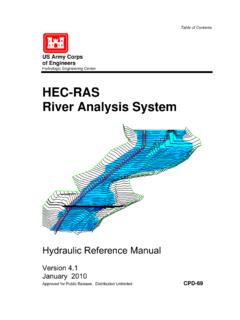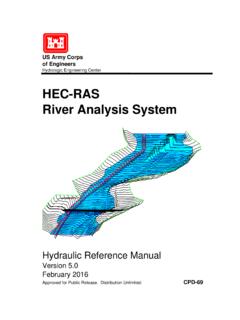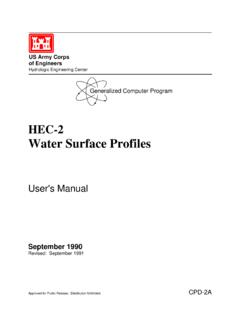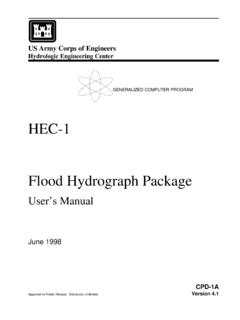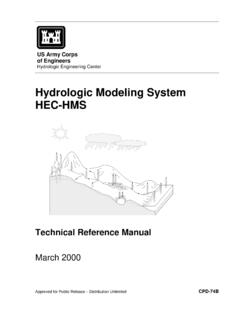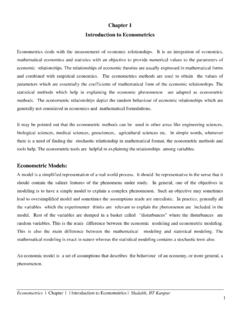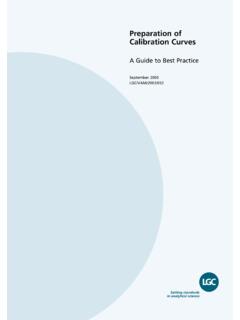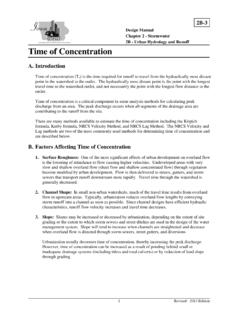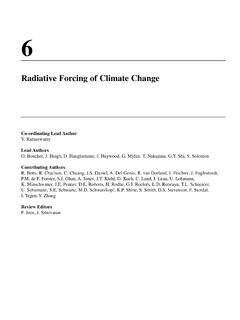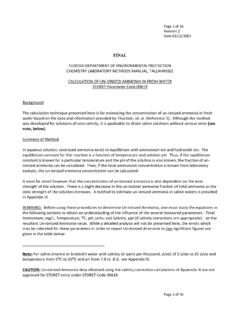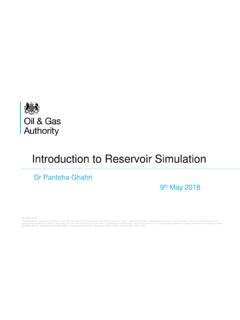Transcription of Using HEC-RAS for Dam Break Studies
1 Using HEC-RAS for Dam Break Studies August 2014. Approved for Public Release. Distribution Unlimited. TD-39. REPORT DOCUMENTATION PAGE Form Approved OMB No. 0704-0188. The public reporting burden for this collection of information is estimated to average 1 hour per response, including the time for reviewing instructions, searching existing data sources, gathering and maintaining the data needed, and completing and reviewing the collection of information. Send comments regarding this burden estimate or any other aspect of this collection of information, including suggestions for reducing this burden, to the Department of Defense, Executive Services and Communications Directorate (0704-0188).
2 Respondents should be aware that notwithstanding any other provision of law, no person shall be subject to any penalty for failing to comply with a collection of information if it does not display a currently valid OMB control number. PLEASE DO NOT RETURN YOUR FORM TO THE ABOVE ORGANIZATION. 1. REPORT DATE (DD-MM-YYYY) 2. REPORT TYPE 3. DATES COVERED (From - To). August 2014 Training Document 4. TITLE AND SUBTITLE 5a. CONTRACT NUMBER. Using HEC-RAS for Dam Break Studies 5b. GRANT NUMBER. 5c. PROGRAM ELEMENT NUMBER. 6. AUTHOR(S) 5d. PROJECT NUMBER.
3 Gary Brunner 5e. TASK NUMBER. 5F. WORK UNIT NUMBER. 7. PERFORMING ORGANIZATION NAME(S) AND ADDRESS(ES) 8. PERFORMING ORGANIZATION REPORT NUMBER. Army Corps of Engineers TD-39. Institute for Water Resources Hydrologic Engineering Center (CEIWR-HEC). 609 Second Street Davis, CA 95616-4687. 9. SPONSORING/MONITORING AGENCY NAME(S) AND ADDRESS(ES) 10. SPONSOR/ MONITOR'S ACRONYM(S). 11. SPONSOR/ MONITOR'S REPORT NUMBER(S). 12. DISTRIBUTION / AVAILABILITY STATEMENT. Approved for Public Release. Distribution Unlimited. 13. SUPPLEMENTARY NOTES. 14.
4 ABSTRACT. This document provides information on how to use the HEC-RAS (River Analysis System) software when performing a dam Break analysis. The document presents the unique hydraulic modeling aspects that are required, plus routing the inflow flood through a reservoir; estimating dam breach characteristics; and, downstream routing/modeling issues. 15. SUBJECT TERMS. HEC-RAS ; hydraulic; model; terrain data; hydrologic; boundary conditions; terrain roughness; hydraulic structures;. calibration; unsteady flow; dam Break ; routing; inflow flood; reservoir; dam breach; downstream; modeling; flood hydrograph; one-dimensional; Saint Venant equations; two-dimensional; level pool routing; scenarios; water surface slope; pool; breach; dam; dynamic wave routing 16.
5 SECURITY CLASSIFICATION OF: 17. LIMITATION 18. NUMBER 19a. NAME OF RESPONSIBLE PERSON. a. REPORT b. ABSTRACT c. THIS PAGE OF OF. ABSTRACT PAGES. U U U 19b. TELEPHONE NUMBER. UU 74. Standard Form 298 (Rev. 8/98). Prescribed by ANSI Std. Z39-18. Using HEC-RAS for Dam Break Studies August 2014. Army Corps of Engineers Institute for Water Resources Hydrologic Engineering Center 609 Second Street Davis, CA 95616. (530) 756-1104. (530) 756-8250 FAX. TD-39. Table of Contents Table of Contents List of Figures .. iii List of Tables .. v Abbreviations.
6 Vii Overview .. 1. Routing the Inflow Flood through a Reservoir .. 1. Full Dynamic Wave Routing .. 3. Level Pool Routing .. 4. Estimating the Dam Breach Characteristics .. 6. Causes and Types of Dam Failures .. 7. Estimating Breach Parameters .. 8. User Entered Data Method .. 8. Simplified Physical Breaching 23. Physically-Based Breach Computer Models .. 24. Peak Flow Equations and Envelope Curves .. 26. Site Specific Data and Engineering Analysis .. 28. Recommended Approach .. 29. Example Application .. 31. Downstream Flood routing/Modeling Issues.
7 35. Cross Section Spacing and Hydraulic Properties .. 36. Computational Time Step .. 38. Manning's Roughness Coefficients .. 41. Downstream Storage, Tributaries, and Levees .. 44. Modeling Bridge and Culvert Crossings .. 47. Modeling Steep Streams .. 48. Drops in the Bed Profile .. 50. Initial Conditions and Low Flow .. 51. Downstream Boundary Conditions .. 53. Using Two-Dimensional Flow Areas for Dam Break Analysis .. 54. 57. i Table of Contents ii List of Figures List of Figures Figure Number Page 1 Error in Level Pool Routing Compared to Full Dynamic Wave Routing.
8 3. 2 Cross Section Layout for One-Dimensional Full Dynamic Routing Through a Reservoir.. 4. 3 Reservoir Pool and Downstream Area Modeled with Two-Dimensional Flow Areas.. 5. 4 Storage Area and Cross Section Layout for Level Pool Routing .. 6. 5 Example Breach Process for an Overtopping Failure .. 11. 6 Example Breach Process for a Piping Failure .. 12. 7 Description of the Breach Parameters .. 14. 8 Summary of Regression Equations for Breach Size and Failure Time (Wahl, 1998) .. 16. 9 HEC-RAS Simplified Physical Breach Option.. 24. 10 Envelope of Experienced Outflow Rates from Breached Dams.
9 28. 11 Dam Break Flood Wave Progression Downstream .. 30. 12 Example Cross Section Layout (Ackerman, 2014) .. 36. 13 Numerical Error Due to Cross Section Spacing .. 37. 14 Example Model Instability Due to Very Short Cross Section Spacing.. 39. 15 Example of Varying Computational Time Step .. 40. 16 Significant Turbulence and Sediment Load During the Teton Dam Failure (Olsen, 1976) .. 43. 17 Cross Section Layout for a Tributary Coming Into a Main Stem River (Ackerman, 2014) .. 45. 18 Example of Using Storage Areas and Lateral Weirs to Account for Flow Reversals up Tributaries (Ackerman, 2014).
10 46. 19 Tributary Storage Modeled as Cross Section Ineffective Flow Areas (Ackerman, 2014) .. 46. 20 Example of Using Lateral Structures and a Storage Area to model a Protected Area .. 47. 21 High Ground (Road or Levee) Represented as Part of the Cross Section .. 48. 22 Example Bridge with Pre-Processed Bridge Curves .. 49. 23 Model Instability Due to a Drop in the Bed Profile .. 51. 24 Example of Initial Conditions for a Reservoir and Lateral Structures Connected to Storage Areas .. 52. 25 Example Model Due to Bad Downstream Boundary Condition.
